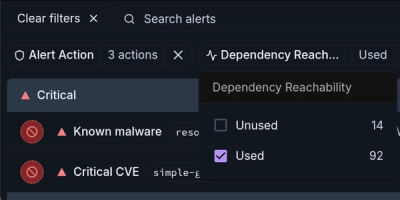
Product
Introducing Module Reachability: Focus on the Vulnerabilities That Matter
Module Reachability filters out unreachable CVEs so you can focus on vulnerabilities that actually matter to your application.
@patterninc/react-ui
Advanced tools
React UI component library for use at [Pattern](https://pattern.com).
React UI component library for use at Pattern.
There are 2 ways to run this project:
pnpm dev and set a frontend override in the application you are working with (Predict, Shelf, etc) in order to see your updates.pnpm storybook to see a local instance of our Library in Storybook.When making updates, it is important to get changes approved by the UX team and front-end team leads. Please utilize Chromatic to demo your updates before getting your PRs raised. Chromatic command - npx chromatic --project-token=cb8f4bc760a6. This will allow you to get quick feedback on UI / UX before getting your code reviewed.
Typescript typechecking happens at build-time, so setting a frontend override won't help with typechecking. To ensure your types still work, you'll need to:
yalc publish in this repo
yalc link @patterninc/react-ui in the repo where the code will be tested (shelf/predict/marketshare/etc.)
After that, you can easily push out updates/changes from here (react-ui) to the other repos by doing:
yalc push --scriptsNote: you can either install yalc globally, or prefix all the previous commands with npx, e.g. npx yalc publish
Do either of the following:
npm version patchpackage.json version field by opening package.json and incrementing the last numberOnce you've tested the types, run
yalc remove @patterninc/react-uiin the repo where this code was tested (Predict/Shelf/Marketshare/etc) to remove yalc changes
npm-publish.yml Github workflow automates the process of publishing a new version of a react-ui package to NPM and bumping the version in another repository. The workflow will run whenever a new commit is pushed to a master branch in react-ui Git repository. It automatically updates the versions of the following repositories.
Step 1: Add Github Actions Workflow to new repository.
Copy the workflow file from the admin repository and replace the repo name with the new repo name from the workflow file and push to master/main branch of repository
Step 2: Modify the npm-publish.yml Workflow to include the new repository version upgrade.
Inside the npm-publish.yml workflow, add a new job before "notify-slack-on-failure"
<new-repo-name>-upgrade-package:
needs: [publish]
runs-on: ubuntu-latest
name: <new-repo-name>-upgrade-package
if: needs.publish.outputs.publish_type != 'none'
steps:
- name: Execute <new-repo-name> GHA workflow to upgrade react-ui package with latest version
uses: convictional/trigger-workflow-and-wait@v1.3.0
with:
owner: patterninc
repo: <new-repo-name>
github_token: ${{ secrets.GHA_RUNNER_TOKEN }}
workflow_file_name: react-ui-package-upgrade.yml
ref: main
We can enable react-ui version bumping for new repositories by making the changes listed above.
FAQs
React UI component library for use at [Pattern](https://pattern.com).
The npm package @patterninc/react-ui receives a total of 3,377 weekly downloads. As such, @patterninc/react-ui popularity was classified as popular.
We found that @patterninc/react-ui demonstrated a healthy version release cadence and project activity because the last version was released less than a year ago. It has 10 open source maintainers collaborating on the project.
Did you know?

Socket for GitHub automatically highlights issues in each pull request and monitors the health of all your open source dependencies. Discover the contents of your packages and block harmful activity before you install or update your dependencies.

Product
Module Reachability filters out unreachable CVEs so you can focus on vulnerabilities that actually matter to your application.

Product
Socket is introducing a new way to organize repositories and apply repository-specific security policies.

Research
Security News
Socket researchers uncovered malicious npm and PyPI packages that steal crypto wallet credentials using Google Analytics and Telegram for exfiltration.